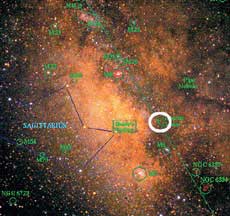 |
The white circle indicates the position of the black hole as proven by scientists. |
After eight years of research, an international astronomy research team led by researcher Shen Zhiqiang from the Shanghai Institute of Technology has accurately found evidence that the Sagittarius A* constellation at the center of the Milky Way galaxy is a supermassive black hole.
Since 1997, Shen Zhiqiang and collaborators, including Lu Guoyong, Director of the National Radio Astronomy Observatory in the United States, Liang Maochang from the California Institute of Technology, He Cengpu and Zhao Junhui from the Harvard-Smithsonian Center for Astrophysics, have focused on this celestial object.
Ultimately, they measured the diameter of Sagittarius A* to be about 150 million kilometers, equivalent to the orbital radius of Earth. The research team successfully captured the closest “electromagnetic image” of this black hole.
The international research team observed through 10 radio telescopes located in the Northern Hemisphere and employed new methods to enhance observational accuracy. They eventually obtained the world’s first high-resolution image at a wavelength of 3.5mm. This spatial resolution is the highest available in the field of astronomy.
Although the successful observational results date back to November 2002, the fact that Sagittarius A* is located in the Southern Hemisphere while most telescopes are in the Northern Hemisphere necessitated a careful analysis of a vast amount of data, extending the process to several years. To observe and measure for five hours, scientists had to wait for 20 months due to the significant impact of weather on the measurement work.
 Black holes are one of the key issues in studying the origins of the universe. A black hole is formed from a collapsing star. There are typically three types of black holes: the first type is the supermassive black hole located at the center of a galaxy; the second type is the stellar black hole, which is about 10 times the mass of the Sun; and the third type is the intermediate black hole, which is situated between the two types above.
Black holes are one of the key issues in studying the origins of the universe. A black hole is formed from a collapsing star. There are typically three types of black holes: the first type is the supermassive black hole located at the center of a galaxy; the second type is the stellar black hole, which is about 10 times the mass of the Sun; and the third type is the intermediate black hole, which is situated between the two types above.
Since even light cannot escape the gravitational pull of a black hole, the celestial body appears completely black from the outside. This makes the search for black holes very challenging for astronomers, who can only infer their existence by observing the behavior of nearby celestial objects that are “swallowed” by the black hole. This also represents one of the most challenging problems in modern astrophysics: how to confirm the existence of black holes through observation.
Regarding the origins of black holes and whether they can disappear, there is still no definitive conclusion. Currently, scientists around the world are collaborating to build the largest radio telescope in the world, composed of high-precision antennas measuring 12 meters in diameter and featuring 64 faces. This telescope is located in the Atacama Desert of Chile, at an altitude of 5,000 meters above sea level, and is expected to begin observations around 2010. In terms of performance, this telescope will surpass the Hubble Space Telescope by approximately ten times, enhancing the study of supermassive objects at the center of the Milky Way.
Tuyet Nhung (According to Xinhua)




















































